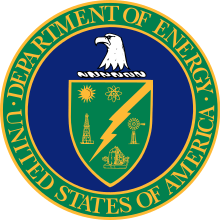Albany Research Center
|
| |
| Established | 1943 |
|---|---|
| Research type | Life cycle research |
Field of research | Metal, alloy, and ceramic |
| Staff | 85 |
| Location |
Albany, Oregon, USA 44°37′13″N 123°7′14″W / 44.62028°N 123.12056°WCoordinates: 44°37′13″N 123°7′14″W / 44.62028°N 123.12056°W |
| Campus | 44 acres (0.18 km2) |
| Affiliations | National Energy Technology Laboratory |
Operating agency | U.S. Department of Energy |
| Website | www.netl.doe.gov |
The Albany Research Center, now part of National Energy Technology Laboratory (NETL), is a U.S. Department of Energy laboratory staffed by Federal employees located in Albany, Oregon. Founded in 1943, the laboratory specializes in life cycle research starting with the formulation, characterization, and/or melting of most metals, alloys, and ceramics; casting and fabrication, prototype development; and the recycle and remediation of waste streams associated with these processes. They routinely solve industrial processing problems by investigating melting, casting, fabrication, physical and chemical analysis and wear, corrosion and performance testing of materials through the use of equipment and analytical techniques. The facility rests on 44 acres (18 ha) and occupies 38 buildings.[1]
History
The United States Bureau of Mines selected a location in Albany to be home to the Northwest Electro-development Laboratory on March 17, 1943.[2] The grounds of the center and some buildings had been the home of Albany College (now Lewis & Clark College) from 1925 until 1937.[3][4] The facility was planned to develop new metallurgical processes as well as study ways to use low-grade resources using the surplus of electricity in the region.[2] In 1945, the name was changed to the Albany Metallurgy Research Center.[2]
Research at the facility in the early years included studying zirconium, which led to advances in producing ductile zirconium under William J. Kroll.[2] This included work with the Navy and the Atomic Energy Commission on development of the USS Nautilus (SSN-571), the first nuclear-powered submarine.[2] In 1955, production of zirconium at the research center stopped when it was taken over by private industry.[2] Other work at Albany included research on titanium casting, recycling metals and alloys, creating sulfurcrete, and studying metal corrosion among other areas.[2]
The center was renamed as the Albany Research Center in 1977, and in 1985 it was listed by the American Society for Metals as a historical landmark.[2] During the mid-1990s until the mid-2000s, the center worked with the Oregon Department of Transportation on preventing corrosion on bridges exposed to salt water.[5] In 1996, the United States Congress eliminated the Bureau of Mines, with the Albany facility then transferred to the U.S. Department of Energy.[2] At first it was a part of the department's Office of Fossil Energy, but in 2005 it became a National Energy Technology Laboratory with the name changing to NETL-Albany.[2] At that time the research center had a staff of 85 people and an annual budget of $10 million.[6] Though the research center began additional upgrades in 2009 to add on two new modular office complexes to the facility and bringing to total staff up to 120 people.[7] During that same year the center received an R&D 100 Award from R&D Magazine.[8]
FUSRAP cleanup
From 1945 until 1978, the Research Center was involved in working with radioactive materials, first for the Atomic Energy Commission and later for the Energy Research and Development Administration.
As part of Formerly Utilized Sites Remedial Action Program (FUSRAP) cleanup operations, a radiological survey was conducted of the site in 1985. Portions of 18 buildings and 37 exterior locations were designated as needing decontamination. The cleanup was done in two phases: Phase I from July 1987 to January 1988 and Phase II from August 1990 to April 1991. The hazardous waste material was sent to the Hanford Site for disposal. The site was certified to Department of Energy standards and guidelines for cleanup of residual radioactive contamination in 1993.[9]
Operations
In conjunction with the Office of Fossil Energy, the facility investigates many of the nation's challenges in the production and use of all types of fossil energy systems to include the need to produce new materials for the energy systems of tomorrow and to develop new methods to ameliorate the releases associated with these new systems.[10] Their two research groups are the Materials Performance Division, and the Process Development Division. Specific research is conducted on oxidation, sulfidation, foil lamination, and several areas related to coal burning.[10] Their facilities include a fabrication plant, corrosion testing area, a melting and casting facility, and a wear and fracture laboratory.[10]
References
- ↑ "National Energy Technology Laboratory". Goldbelt Eagle. Retrieved 11 June 2010.
- 1 2 3 4 5 6 7 8 9 10 "Albany, Oregon History". About NETL. U.S. Department of Energy. Archived from the original on 10 December 2009. Retrieved 10 December 2009.
- ↑ Friedman, Ralph (1990). In Search of Western Oregon. Caxton Press. p. 499. ISBN 978-0-87004-332-1.
- ↑ Corning, Howard M. (1989) Dictionary of Oregon History. Binfords & Mort Publishing. p. 6.
- ↑ Paul, Alex (September 2, 2007). "Bridge work: Albany lab's research prolongs bridge life on salt-soaked coast". Albany Democrat-Herald. Retrieved 10 December 2009.
- ↑ Associated Press (October 3, 2005). "Department of Energy jobs to be put out for bid". The World.
- ↑ Lathrop, Steve (December 10, 2009). "National Energy Technology Laboratory starts facility upgrade". Albany Democrat-Herald. Retrieved 11 June 2010.
- ↑ "Four Albany projects earn awards". Albany Democrat-Herald. August 3, 2009. Retrieved 11 June 2010.
- ↑ "Albany, Oregon, Site Fact Sheet" (PDF). Legacy Management. U.S. Department of Energy. 2009-05-18. Archived from the original on 5 November 2009. Retrieved 2009-11-06.
- 1 2 3 "Laboratory Profile: DOE - Albany Research Center (ARC)". Far West Bulletin. Federal Laboratory Consortium for Technology Transfer. Spring 2004.
